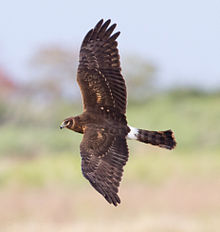by Sue Ann Kendall
For the past couple of years, I have been observing one or more harriers on our ranch property north of Cameron. I will admit that I thought harriers were dogs or airplanes until I looked the bird up on Merlin Bird ID. I thought maybe some of my fellow Master Naturalists would like to learn a bit about these beautiful hawks.

As soon as I spotted one, I had a feeling that these weren’t our usual hawk species around here (red-tails, red-shouldered, kestrels), because of their actions. Rather than sitting on a high perch or flying high and diving, these hawks were skimming the pasture and then diving in for what I assume are mice, since our fields are full of them.
The resources I look at say they are uncommon around here, so I feel lucky to have her flying around here. I say “her,” because the hawk I have been observing is brown, rather than gray like a male would be. You can’t miss the patch of white on her rump area, which is the second main identifier of northern harriers.

Steven Sachs / Audubon Photography Awards
Harriers are fun to watch, since they are lower to the ground while they hunt, and you can get a good look at how they comb the area for food. It’s sort of like a vacuum cleaner, in that they go down a field, turn, and go back a few yards to the left or right of the first pass. Soon enough, something gets caught.
Little did I know how they actually hunt! It turns out they use their ears, unlike most other hawks. According to the All about Birds website from Cornell Labs:
Northern Harriers are the most owl-like of hawks (though they’re not related to owls). They rely on hearing as well as vision to capture prey. The disk-shaped face looks and functions much like an owl’s, with stiff facial feathers helping to direct sound to the ears.
All about Birds
Once I looked further into their behavior, I can see that our land has the kind of habitat harrierw want: lightly grazed pastures along with lots of ponds and marshy areas (hooray for me for making our pond, which is fed by a long arroyo that’s usually damp or wet).
Have any of you seen northern harriers on your property? I know that the literature says they don’t breed here, but I do have the right setting, if they want to.

They are neat, cute owl faces
LikeLike
I also have the Harriers in the field. They are easily spotted because of their distinctive hunting flight. And, amazingly, they can hoover above their target! I’m always delighted to watch them.
LikeLiked by 1 person
Probably the same ones!
LikeLike